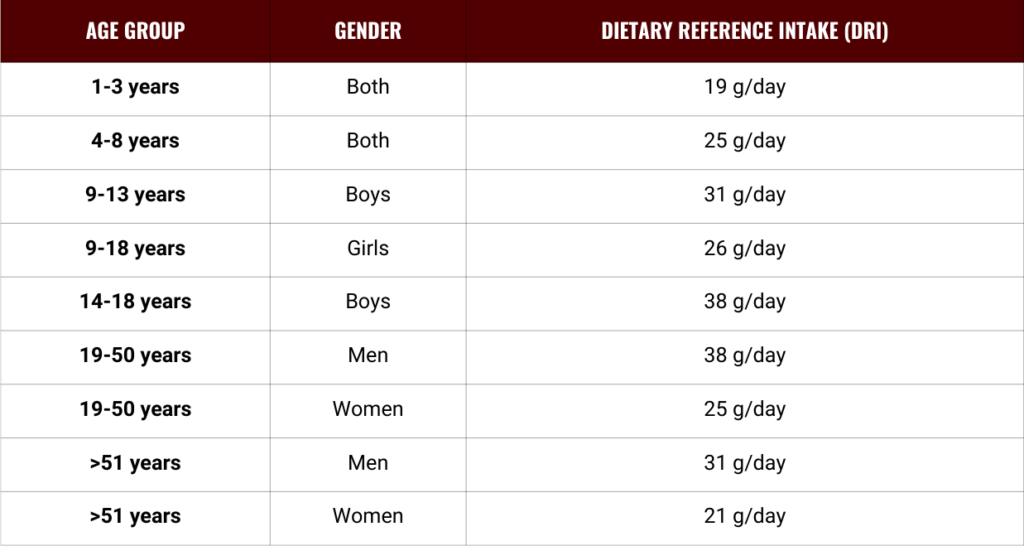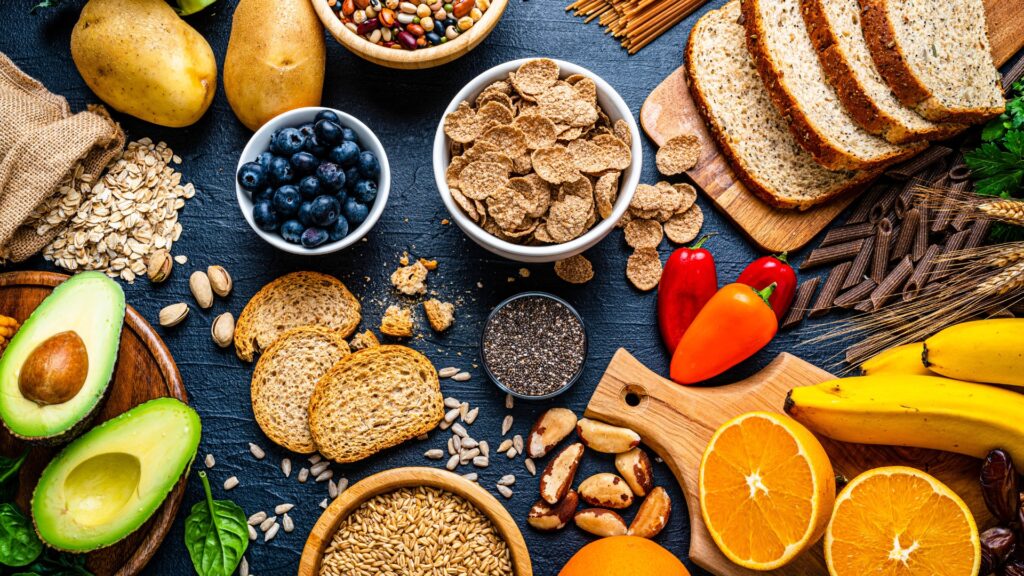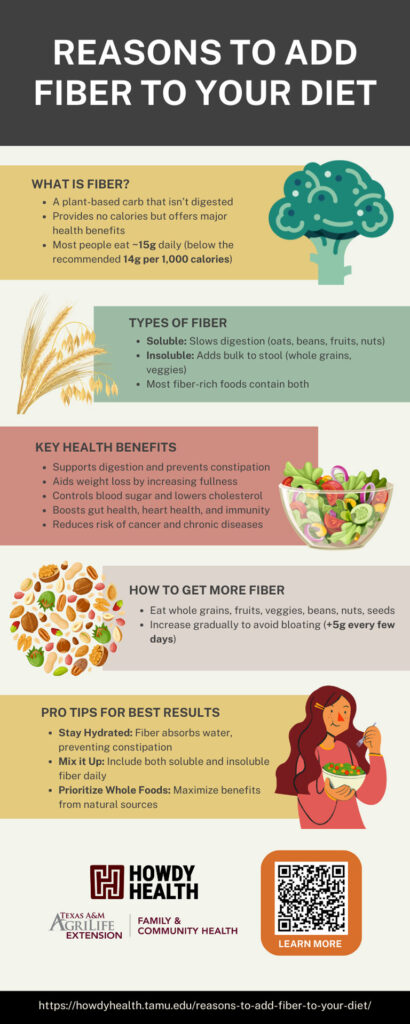Dietary fiber is a type of carbohydrate that’s found in plant sources. Unlike other nutrients (fats, proteins, and other carbohydrates), dietary fiber is the part of the plant food that remains unaffected by the body’s digestive process. Since humans lack the enzymes necessary to digest fiber, the dietary fiber we consume passes through the gastrointestinal (GI) tract undigested and is eventually excreted out of the body.1
As a result, dietary fiber does not provide any calories, yet it offers numerous health benefits. Diets high in dietary fiber have been consistently linked to improved health, yet most people aren’t consuming enough.2,3,4 The average daily fiber intake for Americans is only about 15 grams – significantly below recommended levels.3 Current guidelines suggest consuming 14 grams of fiber for every 1,000 calories eaten.4 Based on age and gender, the current recommendations are shown in the table below. (Note: Since males have larger body size and higher energy intake, their fiber recommendations increase after the age of 8).
Recommended Dietary Fiber Intake

Two Types of Fiber
There are two types of fiber – soluble and insoluble – both are important to have in your diet.
- Soluble fiber dissolves in water and forms a gel-like substance in your stomach, which slows down digestion. Soluble fiber is found in foods such as oat bran, barley, nuts, seeds, beans, lentils, peas, and some fruits and vegetables.1,5
- Insoluble fiber does not dissolve in water and remains mostly intact as it passes through your GI tract. It adds bulk to the stool and helps with the passage of digested food through the stomach and intestines. Insoluble fiber is found in foods such as wheat bran, vegetables (non-starchy), and whole grains.1,5
Most high fiber foods contain both soluble and insoluble fiber, so you don’t have to think too much about which type to choose, instead focus on your overall fiber intake.6 Fiber-rich foods include whole grains, vegetables, fruits, beans, peas, lentils, nuts, and seeds.7 For a more comprehensive list of fiber-rich foods, see the Dietary Guidelines for Americans Food Sources of Dietary Fiber.
Health Benefits
Adding fiber to your diet can yield numerous health benefits. Here are 8 reasons why it’s worth prioritizing.
1. Improved Digestive Health
Fiber plays a critical role in maintaining a healthy gastrointestinal (GI) system. Insoluble fiber, found in whole grains and the skins of fruits and vegetables, adds bulk to stool, promotes regular bowel movements, and prevents constipation. These actions support colon health and may reduce the risk of diverticular disease.8
2. Weight Management
By slowing down digestion, high-fiber foods can help you feel full longer after you eat. This helps reduce overeating and thus reduces overall calorie intake. Studies have found a correlation between higher fiber intake and lower rates of obesity.3,9,10,11,12
3. Blood Sugar Control
Soluble fiber slows the absorption of sugar in the digestive system, stabilizing blood glucose levels and improving insulin sensitivity. This makes it particularly beneficial for individuals managing or at risk of type 2 diabetes.7,11,13,14
4. Lower Cholesterol Levels
Soluble fiber binds to bile acids in your digestive tract, preventing their reabsorption into your body and promoting their excretion. Since bile acids are made from cholesterol, your liver has to use more cholesterol to make new ones. This helps lower your total cholesterol levels, including “bad” LDL cholesterol, which is good for your heart health.3,15,16
5. Enhanced Gut Microbiome & Immune Function
Soluble fiber, particularly prebiotic fibers (fibers that get fermented in the gut), serves as food for beneficial gut bacteria.7 These fibers help foster a healthy gut microbiome, which has been linked to improved immunity, better digestion, and even enhanced mental health.8 Beneficial bacteria produce short-chain fatty acids (SCFAs) that reduce inflammation and support colon health.8,17,18
6. Reduced Risk of Cardiovascular Diseases
A high-fiber diet has been associated with a lower risk of heart disease and stroke. Fiber can help reduce blood pressure, improve cholesterol levels, and decrease inflammation, all of which support cardiovascular health.11,15
7. Reduced Risk of Certain Cancers
High fiber intake has been linked to a decreased risk of several cancers, especially colorectal cancer, by promoting a healthy gut environment and reducing inflammation. The production of short-chain fatty acids (SCFAs) and timely and proper waste elimination may collectively lower carcinogenic activity in the colon.11,19
8. Comprehensive Chronic Disease Prevention
Regular fiber consumption has been inversely associated with the risk of most diet-related chronic diseases such as obesity, type 2 diabetes, certain cancers, and cardiovascular diseases.19,20 By supporting healthy digestion, weight management, and metabolic health, fiber plays a key role in long-term disease prevention.
Reaping the benefits of fiber
To reap the full health benefits of dietary fiber, aim to consume a variety of plant-based foods, ensuring a balance of both soluble and insoluble fibers.
Add fiber gradually
If you haven’t been eating much fiber, be sure to increase gradually – adding too much too quickly can lead to bloating, gas, constipation, or stomach cramps. Gradual increases allow your digestive system to adjust to the higher fiber content, reducing the likelihood of these side effects. To increase fiber gradually, try adding a small portion of high-fiber foods to your meals each day, such as fruits, vegetables, whole grains, or legumes. Increase your fiber intake by 5 grams every few days until you reach the recommended daily intake. This approach can help maximize the benefits of fiber while minimizing any unpleasant side effects.
Hydrate
Fiber works best when you’re adequately hydrated, as it absorbs water to help move food through the digestive tract. Increasing water intake alongside fiber helps prevent constipation or discomfort.21
Choose a variety of fiber-rich foods to be sure you’re getting both types of health-benefitting dietary fiber. Strive for the recommended daily dietary fiber intake from whole food sources to support digestion, heart health, and overall well-being.
Infographic
Download the PDF or share the image below to help others learn more about the reasons to add fiber to your diet.
References
- Mount Sinai Health System. Soluble vs. Insoluble Fiber, 12 Aug. 2024, www.mountsinai.org/health-library/special-topic/soluble-vs-insoluble-fiber#:~:text=There%20are%202%20different%20types,This%20slows%20digestion.
- Korczak R, and Slavin JL. Definitions, regulations, and new frontiers for dietary fiber and whole grains. Nutrition Reviews, vol. 78, no. Supplement_1, 30 July 2020, pp. 6–12, https://doi.org/10.1093/nutrit/nuz061.
- Soliman GA. Dietary Fiber, Atherosclerosis, and Cardiovascular Disease. Nutrients. 2019; 11(5):1155. https://doi.org/10.3390/nu11051155.
- American Society for Nutrition. Most Americans are not getting enough fiber in our diets. 9 June 2021, nutrition.org/most-americans-are-not-getting-enough-fiber-in-our-diets/.
- U.S. Department of Agriculture WIC Works Resource System. Eye on nutrition: Fiber. Accessed February 6, 2025. https://wicworks.fns.usda.gov/resources/eye-nutrition-fiber#:~:text=Soluble%20fiber%20is%20found%20in,bran%20and%20non%2Dstarchy%20vegetables.
- Medical News Today. Dietary fiber: Why do we need it? Accessed February 6, 2025. https://www.medicalnewstoday.com/articles/146935#types-of-fiber.
- Timm M, Offringa LC, Van Klinken BJ-W, Slavin J. Beyond Insoluble Dietary Fiber: Bioactive Compounds in Plant Foods. Nutrients. 2023; 15(19):4138. https://doi.org/10.3390/nu15194138.
- Slavin JL. Fiber and prebiotics: mechanisms and health benefits. Nutrients. 2013;5(4):1417-1435. Available at: https://doi.org/10.3390/nu5041417.
- Howarth NC, et al. Dietary fiber and weight regulation. Nutr Rev. 2001;59(5):129-139. Available at: https://doi.org/10.1111/j.1753-4887.2001.tb07001.x
- Hervik AK, Svihus B. The Role of Fiber in Energy Balance. J Nutr Metab. 2019 Jan 21;2019:4983657. doi: 10.1155/2019/4983657.
- Waddell IS and Orfila C. 2022. Dietary fiber in the prevention of obesity and obesity-related chronic diseases: From “Epidemiological Evidence to Potential Molecular Mechanisms.” Critical Reviews in Food Science and Nutrition 63 (27): 8752–67. doi:10.1080/10408398.2022.2061909.
- Slavin JL. Dietary fiber and body weight. Nutrition. 2005;21(3):411-418. doi:10.1016/j.nut.2004.08.018.
- Post RE, et al. The role of fiber in managing blood sugar. JABFM. 2012;25(1):16-23. Available at: https://doi.org/10.3122/jabfm.2012.01.110193.
- Post RE, Mainous AG, King DE, Simpson KN. The Journal of the American Board of Family Medicine January 2012, 25 (1) 16-23; DOI: https://doi.org/10.3122/jabfm.2012.01.110148.
- PubMed. Fiber intake and cancer risk. 2020. Available at: https://pubmed.ncbi.nlm.nih.gov.
- Brown L, Rosner B, Willett WW, Sacks FM. Cholesterol-lowering effects of dietary fiber: A meta-analysis. The American Journal of Clinical Nutrition. 1999;69(1):30-42. doi:10.1093/ajcn/69.1.30.
- Satija A, Hu FB. Cardiovascular benefits of dietary fiber. Current Atherosclerosis Reports. 2012;14(6):505-514. doi:10.1007/s11883-012-0275-7.
- Marlett JA, McBurney MI, Slavin JL.Position of the American Dietetic Association: Health Implications of Dietary Fiber, Journal of the American Dietetic Association, Volume 102, Issue 7, 2002, Pages 993-1000, ISSN 0002-8223, https://doi.org/10.1016/S0002-8223(02)90228-2.
- Fatima I, Gamage I, De Almeida RJR, Cabandugama P, Kamath G. Current Understanding of Dietary Fiber and Its Role in Chronic Diseases. Mo Med. 2023 Sep-Oct;120(5):381-388. PMID: 37841565; PMCID: PMC10569388.
- Lattimer JM, Haub MD. Effects of dietary fiber and its components on metabolic health. Nutrients. 2010 Dec;2(12):1266-89. doi: 10.3390/nu2121266. Epub 2010 Dec 15. PMID: 22254008; PMCID: PMC3257631.
- Hermann JR. Dietary Fiber – Oklahoma State University. Dietary Fiber | Oklahoma State University. October 9, 2019. Accessed February 6, 2025. https://extension.okstate.edu/fact-sheets/dietary-fiber.html.



